Government - Community collaboration for natural ecological sustainability-Yi Hsin Community, Nantou
14.10.2021
SUBMITTED ORGANISATION
SWCB (Soil and Water Conservation Bureau)
OTHER CONTRIBUTING ORGANISATIONS
Department of Leisure & Recreation, National Formosa University.
Yi Hsin Community Development Association.
DATE OF SUBMISSION
14/10/2021
REGION
Asia
COUNTRY
Chinese Taipei
LOCATION
Puli Township of Nantou City, located in center part of Taiwan island
KEYWORDS
Yi Hsin Community, habitat creation, Pararasbora moltrechti restoration, government – Community collaboration
AUTHOR(S)
|
Chen-Yang Li1, Jung-Chun Chen2, Ta-Ching Liang3, Ming-Cheng Chen1, You-Tsen Lin4 and Pei-Yi Lin4, Kuo-Dong Peng5 1Soil and Water Conservation Bureau (SWCB), NNo.6, Guanghua Rd., Nantou City, Nantou County 54044, Taiwan (R.O.C.) 2 Nantou Branch SWCB, No.350, Fuxing Rd., Nantou City, Nantou County 54062, Taiwan (R.O.C.) 3Department of Leisure & Recreation, National Formosa University (NFU), No. 64, Wenhua Rd., Huwei Township, Yunlin County 63230, Taiwan (R.O.C.) 4Yi Hsin Community Development Association, No. 56, Yongfong Rd., Puli Township, Nantou County 54544 , Taiwan (R.O.C.) 5National Chi Nan University, No.1, University Rd., Puli Township, Nantou County 545, Taiwan (R.O.C.) |
Summary Sheet
The summary sheet for this case study is available here.
Abstract
Yi Hsin Community is the major production area of water bamboo in Taiwan. Excessive agricultural behavior and artificial development in the early period resulted in the destruction of the ecology and water source environment, and the native fish in Taiwan, Pararasbora moltrechti, suffered from the crisis of extinction. The Council of Agriculture, Executive Yuan, proclaimed Pararasbora moltrechti as a rare protected species in 2009 (Council of Agriculture Executive Yuan R.O.C [COA], 2009), when it was estimated that there were merely 1000 left; the quantity was less than Oncorhynchus masou formosanus. The residents therefore started to think about the relationship between humans and the environment and started the process of industrial transformation and Pararasbora moltrechti restoration. The community participated in the Rural Regeneration Plan in 2011, and the community residents co-participated in discussions, expecting to find a business model for community enterprise and Pararasbora moltrechti restoration. Meanwhile, a friendly ecological environment was promoted to enhance agricultural quality with ecology-friendly farming as well as to protect the water source and biological habitat. Local farmers were also encouraged to replace conventional agriculture with non-toxic planting to successfully induce community residents to join in the green conservation lable (COA,2015) and put organic concepts into practice.
To continuously promote the importance of environmental education and induce more friendly farmers, Yi Hsin Community cooperated with government agencies to introduce a ecological tourism model into community enterprise, and youths successively returned to the community to assist in managing orchards and farms in recent years. Friendly farming areas and agricultural products were also stably expanded in the community. This kind of ecosystem protection based diverse partnership did not simply reinforce the resilience of the ecosystem, but also created support and public expenditure for the development of sustainable use, with significant results. The practice and successful experience could be taken as a demonstration case in Taiwan and serve as a reference for other areas with ecosystem degradation problems.
Social economy and environment characteristics of the area
Yi Hsin Community is a village in Puli Township, Nantou County, Taiwan, (Figure 1), with the total area about 500 hectares. The community, where the Tainiukeng River, Yenliaokeng River, and Changhukeng River converge(Figure 3), is surrounded by mountains presenting basin topography. The annual rainfall is about 2120mm, and the mean annual temperature is 20~21℃. July is the warmest month, with the maximum temperature 33℃, and January is the coolest month, with the minimum temperature about 10℃. The settlement population is 1,169 with about 265 households. Primary industries are the main sources of income, and more than 90% of community residents live on farming, mainly planting water bamboo, loofah, and passion fruit. The planted area of water bamboo is about 40 hectares. However, under the guide of the community director in the past years, it has gradually changed from single industry to diverse sources of income.
Pararasbora moltrechti was proclaimed to be a rare protected species by the Council of Agriculture, Taiwan, in 2009 (COA, 2009). It was a common fish previously in Taiwan because there was no use of agricultural chemical in the farm lands making most farm environments to be a perfect shelter for –Pararasbora moltrechti during flooding and dry season. Debris flow due to heavy rain from typhoons resulted in a sharp decrease in Pararasbora moltrechti. Because Pararasbora moltrechti need clean water with moderate temperature to survive therefore, only remaining 5 rivers offer habitat for Pararasbora moltrechti in Taiwan now (Taiwan Public Television Service Foundation-Our land, 2021), and three of them are in Yi Hsin Community, including the Tainiukeng River, Yenliaokeng River, and Changhukeng River. Yi Hsin Community is therefore considered to be the best place for Pararasbora moltrechti restoration (Figures 2 & 3) (Li, 2019).

Figure 1. Yi Hsin Community located in Puli Township, Nantou County, Taiwan,

Figure 2. Landscape used in Yi Hsin Community

Figure 3. Aerial view of the production landscape in Yi Hsin Community, where water bamboo are mainly planted. Other agricultural products include black tea, cinnamon, loofah, and papaya. The community, where the Tainiukeng River, Yenliaokeng River, and Changhukeng River converge, is the most suitable place for Pararasbora moltrechti restoration in Taiwan. (2020/10/19)
Description of the interaction between people and nature in the area
The agricultural model gradually changed from retail sales to increased productivity for price competition from 1950~1960. In order to increase productivity, farmers used agricultural chemicals to against plant diseases and pests, e.g. herbicides and pesticides. This resulted in soil acidification and degradation, directly and indirectly polluting the surrounding natural environment (including rivers) and resulting in the disappearance of Pararasbora moltrechti.
Water form groundwater or spring is required for the growth of water bamboo, resulting in low water resource utilization efficiency. (Lan, 2018) Furthermore, the arable land area in Taiwan is limited to a small area. Both dense population and high mountain topography have resulted in unbalanced distribution of water resources. Furthermore, due to development of upstream lands by foreign enterprises, the natural ecological environment of rivers and the surrounding farms in downstream of Yi Hsin Community have been covered by mud and rocks scoured from upstream areas by heavy rain, during typhoon season resulting in the disappearance of wild habitat for Pararasbora moltrechti further. (Figures 4 & 5).
For environmental restoration and ecological sustainability, the community has cooperated with various ministries to establish a platform and has persuaded 16 local farmers to change from conventional agriculture to friendly farming. The community has also introduced an experiential economy model to promote the biological diversity of the local environment.

Figure 4. Disappearance habitat after soil and rock accumulation caused by debris flow

Figure 5. River band scouring and land erosion caused by floods
Fundamentals
In order to resolve the problems of the environmental disruption and community industrial homogeneity of Yi Hsin Community, the residents have reached consensus through long-term discussions and decided to work to toward the goal of “co-existence between humans and ecology”. Through cooperation with government and private agencies with different characteristics, the community has been assisted in establishing related software and hardware as well as professional training. The course topics and contents are planned by community residents to successfully induce the participation of other community residents and gradually perfect the development goal of the community. Yi Hsin Community, through friendly agriculture, has implemented a model of prosperity with ecology for 7 years to gradually recover the local ecology, and the agricultural production has changed from original primary production to a secondary (processing) and tertiary (service) agricultural economy.
Goal
The record and analysis of Yi Hsin Community, which reduces artificial damage on natural environment and develops diverse incomes through government – Community collaboration, prove that Yi Hsin Community manages the local Socio-ecological production landscapes and seascapes [SEPLS] based on the concept of “co-existence between humans and ecology” (Council of Agriculture, Executive Yuan, Soil and Water Conservation Bureau, 2018).
- It aims to restore the degraded ecosystem through conservation and recovery to slow down and adapt to climate change as well as to contribute to desertification control (Aichi Targets 15) (Lin, 2016)
- Based on biological diversity and ecosystem protection, the community promotes diverse partnerships, agencies with common ideas are combined to create support and public expenditures are allocated for the development of sustainable use (SDGs 15) (Scholes et al., 2018).
- Environment friendly agriculture is constructed to enhance the biological diversity in the area for ecological conservation and restoration.
- Conventional agriculture replaced with non-toxic agricultural technology to promote agricultural product value and increase income sources with a diverse experience economy.
Engaged activity and/or practice
1. Improvement of residential environment and enhancement of self-capability
In order to reinforce self-capability, Yi Hsin Community participated in the “Rural Regeneration Plan” of Soil and Water Conservation Bureau (SWCB) in 2011-2013, with 40 people completing the course. Various training courses were also proposed by the SWCB (Table 1). The “Rural Regeneration Plan” contained four stages. At Stage 1 (Local Concern Stage) of the ”Rural Regeneration Incubation Program”, residents learnt basic concepts and policies of rural development programs and gained a better understanding of the place where they live. In 2012, they moved on to the Intermediate Stage to learn about environmental issues common to rural communities, as well as the causes and consequences of environmental problems. At the Core Competency Stage in 2013, residents to communities were taught to conduct local resource surveys and to improve their agricultural environments. All of these” learning-by-doing” activities were decided upon and implemented by residents themselves, but the labor cost and material purchased were covered by the SWCB. (Chao et al., 2019) Nevertheless, residents in Yi Hsin Community were comparatively conservative, and many were not willing to make speeches in formal meetings; therefore, the residents were asked about concerning issues through interviews in frequent gathering places, such as under old trees, temple court, and the activity center. Responses to interviews were collected and organized as the community meeting contents. Based on these contents, course planning and improvement programs were proposed for the residents (Table 2). The relevant expenditures and costs were subsidized by the SWCB. Finally, in the Regeneration stage in 2014, the residents could independently manage the community through rolling reviews and various action programs developed, according to current situations, to move the move the community towards the goal of sustainable development.
Table 1. Training courses for the Rural Regeneration Plan in 2011-2020

Table 2. Development goal of community in 2011-2014 under the Rural Regeneration policy of Soil and Water Conservation Bureau

2. Government - Community collaboration, carrying out the duties
Yi Hsin Community used to co-inspect the potential problems of daily life through community resident meetings. Since community construction and green conservation lable system were put into practice in 2011, improvement programs were made to renovate the hardware of ecological pools and environmental education places in order to achieve safety in the farm ecosystem. The exclusive species in the community, Pararasbora moltrechti, is regarded as the biological indicator to inspect the ecology of the farm environment in the community. Lin, You-tsen, who returned home to the village at the time, was the demonstration farmer that lead the trial and co-manage the community with the former director. With household promotion, the ideas of environmental protection and friendly ecology were delivered to the residents. Various environmental education and friendly agriculture related courses were conducted in the past decade to induce local enterprises and other farmers to make the transition toward production with a friendly environment and non-toxic agriculture. For those with willingness but weak in action, the association created various types of courses based on residents’ needs, in order to promote various roles for participating in community affairs. Most importantly, the association facilitated negotiation and discussion with government agencies, experts & scholars, and enterprises to address inadequacy of resources, and even enhanced self-capabilities to make improvement plans for seeking external assistance and resources (Table 3). These efforts were expected to enhance the balanced development of society-production-ecology in the community. The details of the cooperative efforts of Yi Hsin Community and various agencies are listed as follows.
Table 3. Cooperation between Yi Hsin Community and various agencies
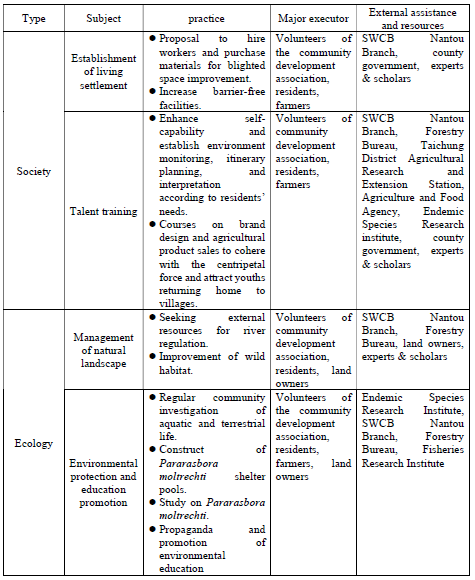
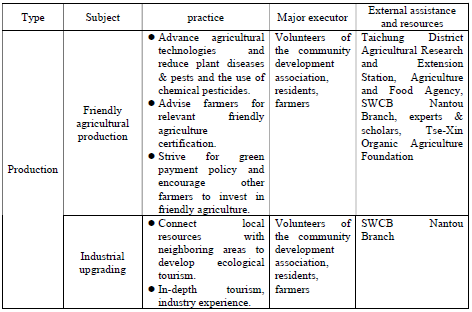
3. Natural environment and species restoration
Pararasbora moltrechti was originally distributed in Dajia River, Wu River, and Zhuoshui River. Along with river pollution and construction with cement, Pararasbora moltrechti in most areas is disappearing. The Council of Agriculture designated it as rare protected species in 2009, when it was estimated that merely 1000 were left in Taiwan. The preciousness of Pararasbora moltrechti is apparent.
With pure and clean water, Puli, Nantou, is the main intensive area for Pararasbora moltrechti in Taiwan. Unfortunately, the planting of water bamboo and enterprises largely developing the upstream land have resulted in the shortage of water for Pararasbora moltrechtihabitat and heavy rain has brought erosion of soil and rock to destroy the habitats further. In 2019, Taiwan was for the first time inundated by continuous rainstorms not caused by typhoons. Parts of the embankment on both sides of the upstream rivers in Yi Hsin Community collapsed, and a lot of sediment moved towards and deposited downstream from Yi Hsin Community. This did not simply bury the wild ecological habitat of Pararasbora moltrechti to sharply reduce the quantity, but also eroded water bamboo farms on the river bank.
Fortunately, the problem was noticed by the community in 2014. In order to conserve the source of Pararasbora moltrechti, the community residents formed the fish conservation team (Figure 6), with the guidance of experts & scholars, to address the water level of rivers and artesian volume in the community; even land owners sacrificed farming land and income to provide for the construction of Pararasbora moltrechti shelter pools without compensation (Figure 7). In this case, Pararasbora moltrechti, when the water level of rivers was reduced, could be immediately moved to the shelter pools with a stable volume and environment, and moved back to the natural river in the reproductive period or when there was enough water. About 2,920 Pararasbora moltrechti were in artificial shelter pools in Yi Hsin Community by 2020 (Figure 8).

Figure 6. Fish conservation investigators observing stream ecology

Figure 7. Shelter pools for Pararasbora moltrechti constructed on private land (2014)
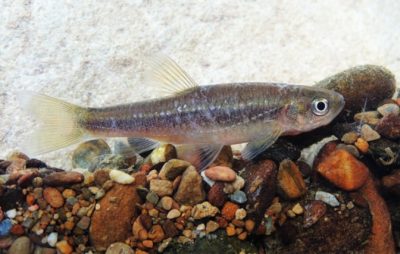
Figure 8.Lateral view of Pararasbora moltrechti
Communities located between cities and rural as a buffer, land development and agricultural irrigation carried out upstream affects the water use and ecological environment in the downstream area of Yi Hsin Community. Although there are artificial ecological shelter pools for Pararasbora moltrechti, the overall ecological environment of the rivers is considered as the fundamental problem for the community (Wu et al., 2021). The meeting for the Pararasbora moltrechti conservation cross-domain platform was proposed in 2020, when relevant agencies collaboratively appealed to neighboring developers to fulfill their social responsibility and obligation. Meanwhile, the SWCB also planned to provide the budget of about 25million NT dollars for regulating the community rivers (Lee et al., 2018) as well as improving channel fill deposits and constructing diverse water environment ecological habitat with ecological engineering (Figure 9).
At the construction planning stage, the construction unit was asked to invite relevant agencies and experts & scholars for a site meeting (Figure 10) and expand upon the suggestions from fish experts and ecological scholars (Table 4) to reduce impacts on ecological environment and take care of resident safety; the supervision unit was entrusted with carrying out a rolling review during the construction period. The construction plan is still in the planning and design phase. The latest design ideas aiming at habitat restoration are listed as follows.


Figure 9. Eco- friendly construction design diagram
Picture source: Lee et al., 2018
Table 4. Soil and Water Conservation Bureau’s application of ecological engineering to river dredging and the optimization effect

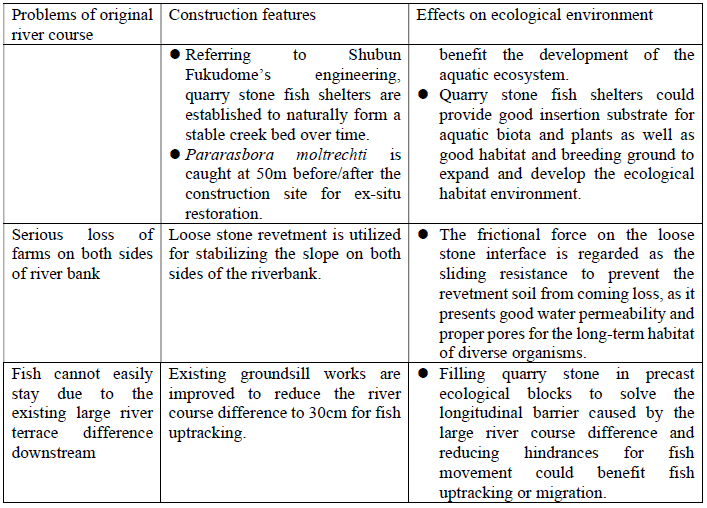

Figure 10. On-site survey discussion before construction
4. Transformation of conventional agriculture
Yi Hsin Community presents the vision of “co-existence between humans and ecology”, to make a living for community members when conserving the ecology. Productivity was reduced when community farmers change from original conventional agriculture to friendly and non-toxic planting. To solve the problem, the community acquired new concepts and practices from experts in agricultural technology, e.g. safe agricultural technology, labor saving techniques, reuse of water bamboo husks, an automatic liquid manure spreading system, and use of LED light for saving energy, and preceded with organic or green conservation label certification (Figure 11) to enhance the creditability of non-toxic and healthy agricultural products while promote the value of agricultural products through third-party verification beyond producers and consumers.
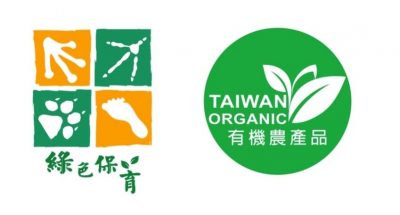
Figure 11. Farmers transforming towards organic farming and applying for verifications of green conservation labels and organic agricultural products
The framers in Yi Hsin Community prevented and controlled plant diseases and pests with fertilizers made of organic materials (Figure 12) or physical method such as friendly farming. Sex pheromone insect traps were hung on the farm (Figure 14) to induce most male insects and reduce the opportunity for mating with female insects to further reduce pest spawning and the population density of the next generation (Lan, 2018). In addition to controlling plant diseases and pests, field lighting has been also applied to control the production period. Under the instruction of experts & scholars and government departments, the use of LED lighting for water bamboo at night has significantly reduced electricity fees (Figure 13).

Figure 12. The community applies organic materials for farming

Figure 13. Stunting disease were resulted from the early formation of gall in plants when they are too young under short daylength. Thus the stunting disease could avoided by night lighting at young plant age when planted early.(Huang et al.,2018)

Figure 14. Insect traps are normally placed on the edge of farms to attract pests
In the demonstration farms (Figure 15), Yi Hsin Community farmers produce water bamboo and restore secondary conservation “Pararasbora moltrechti” to promote “fish and water bamboo symbiosis” (Figure 16). Water for Pararasbora moltrechti is also the water for planting water bamboo. This has become the local ecological and industrial indicator. Furthermore, diverse income is created through the promotion of farming and ecological education experience to make up for and improve the loss of production value in the farming transition period as well as enhancing the development of ecological conservation to show the importance environmental ecology protection to visitors through interpretation.

Figure 15. Demonstration farms in Yi Hsin Community

Figure 16. Conceptual diagram of fish and water bamboo symbiosis


Figure 17. Introduction of economic models of farming experience and pickled water bamboo DIY to create diverse income
Result
1. Cohering community strength
The residents sat on the fence in the beginning when it came to environmental protection, industrial transformation, and capacity building; however, when things got started, they changed themselves and began to be performed. The dream seeds in other residents’ mind then gradually grew. Meanwhile, the mission of “participating in public affairs” was promoted to others through experience leading to feedback in the community.
Through continuous participation in training programs offered by the SWCB and education programs developed by the community, Yi Hsin Community members started from a demonstration farm and slowly expanded. Now, they enhance their knowledge and skills and spontaneously participate in local public affairs, take natural ecological sustainability and the overall environment into account before environmental construction, and grasp the development of local economic industries. The development in society, ecology, and production are relatively stable and advanced.
2. Government - Community collaboration, carrying out duties
Issues related society, ecology, and production in Yi Hsin Community are brought up by the community and government departments, or experts & scholars, for discussion and planning. Nevertheless, the involved problems are rather broad. For instance, factors in the maintenance of natural habitat include agricultural pollution, soil and rock stacking, restoration technology, and residents’ environmental education; such problems involve distinct specialties and duties. In these cases, the community has accumulated broad-ranging practical experiences and connections with experts & scholars and even staff in government departments to found good relationships between Yi Hsin Community and public/private agencies.
Since 2011, Yi Hsin Community strove to create a survival environment for Pararasbora moltrechti and eventually established the “Pararasbora moltrechti conservation cross-domain platform” in 2020. Meetings with 17 agencies, including the SWCB Nantou Branch, Forestry Bureau, Agriculture and Food Agency, Nantou Forest District Office, Endemic Species Research Institute, Taichung District Agricultural Research and Extension Station, Fisheries Research Institute, Tse-Xin Organic Agriculture Foundation, and experts & scholars have been held every 4~6 months. Aiming at river regulation, habitat management, and a friendly environment, the responsibilities have divided and Yi Hsin Community is continuously guided and assisted in the execution to collaboratively maintain the environment (Figure 18) (Healay, 1998).


Figure 18. Implementation of Pararasbora moltrechti conservation cross-domain platform meeting by those carrying out the duties
After the first meeting in March, 2020, the SWCB closely communicated with local residents about the construction of the riverbank habitat. The problems of original riverbank scouring, soil and rock stacking, and habitat destruction were proposed, and experts & scholars in various fields and relevant agencies were invited to discuss suitable improvement programs for maintaining existing farming areas and native trees as well as reaching consensus for creek regulation through ecological engineering. Moreover, under the sustainability of the overall ecological environment, the upstream land development in Yi Hsin Community also needed discussion. The SWCB, Shennong Foundation, and community residents therefore conversed with the developer in January, 2021. (Shennong Foundation is people organization,playing a role of developer to design and planning.) The developer understood permaculture concepts for planning the farm in the future and was glad to apply ecological engineering for maintaining the survival space of Pararasbora moltrechti along the upstream of Tainiukeng River.
3. Natural environment and species restoration
Residents in Yi Hsin Community have begun to emphasize environment maintenance and natural conservation, and the establishment of Pararasbora moltrechti shelter pools has increased from original 1 to 5 (Table 5). These pools are collaboratively managed by land owners and the community association. Working holiday and volunteer experience activities have recently included to promote the principle of a friendly environment in the community and implement environmental education. Furthermore, the income from educational activities could reduce the expenses needed for community maintenance.
Table 5. Number and area of Pararasbora moltrechti shelter pools

Data source: International Conference Forum for the 20th Anniversary of the 921 Earthquake
After several years of trials, the shelter pools still had problems including low water levels, high water temperatures, drying up in the dry season, and loss of water source. The regulation was established in 2020, under which tarpaulin pavement and gravel slope protection were applied to enhance water retention and biopores, avoid long-term water leakage and water shortage during drought, create internal height difference, deepen local depth to retain water, avoid enhancing water temperature, and maintain the survival of aquatic life (Figure 9).


Figure 19. Construction design concept for repairing Pararasbora moltrechti shelter pools and the current condition (2020)
After several years of efforts by the community, there are about 2,920 Pararasbora moltrechti in shelter pools. The restoration of Pararasbora moltrechti is proof of the recovery of the habitat. It results in the recovery of the surrounding ecosystems, such as clean water sources, dense aquatic plants in pools (Da-Ann Hygrophila, Nuphar shimadae), honey plants next to pools attracting butterflies, and neighboring organisms coming to stay. In addition to Pararasbora moltrechti in the water, biodiversity in the ecological chain has also been restored, as indicated by the presence of loaches, shrimp, birds, frogs, and dragonflies. (Barrett et al., 2011)
In the COMDEKS (Community Development and Knowledge Management for the Satoyama Initiative) evaluation in 2019 (Dunbar, 2019), it was discovered that biological diversity (including agricultural biological diversity) in the community required urgent improvement, because the community focused on the conservation of aquatic life (Pararasbora moltrechti) but ignored creatures on the land. The land creature monitoring plan was started in 2020 (Figure 20); by 2020, Helictis subaurantiaca was mostly observed with infrared, followed by Formosan muntjac, rodents, and Gem-faced civets (Swinhoe). There were 19 species monitored. (Yi Hsin, Unpublished thesis)


Figure 20. Mammals including Helictis subaurantiaca and Formosan muntjac were photographed during land creature monitoring (October, 2020)
Current fieldwork in the community (Figure 21) has been carried out (daily, weekly, or monthly, depending on species) to understand the adaptation and migration of creatures on the land. Meanwhile, changes in quantity and structure have been recorded for successive regular monitoring (Figure 22) to ensure the recovery of the entire ecology in the community.


Figure 21. Land ecology and footprint survey


4. Transformation of conventional agriculture
Since Yi Hsin Community started to manage the agricultural production areas in 2011, the transformation, from being laughed at and distrusted in the beginning, to establishment of successful eco-friendly water bamboo farms, has lasted for a decade. The community seriously faced the problems related to society, ecology, and production step by step and tried to find solutions; successful experiences were applied to influence other farmers and experience in organic farming was introduced to the industrial development of the community, e.g. black tea, cinnamon, and coffee. Such promotion of eco-friendly industry through trial mechanisms of demonstration farms enhanced the income diversity of local farmers and increased the area for organic farming in the community.
The experience of Yi Hsin Community shows that field experience and ecological interpretation activities can be used in the transition period of changing from conventional agriculture to friendly farming. The economic benefits from experience are not comparable to the original income, but largely reduces farmers’ losses during the transition period. After friendly farming was put into practice in 2016, the model was continued to manage the water bamboo industry in Yi Hsin Community and successfully the participation of other industries has been successfully accomplished in the community. Current community enterprise applies diverse business models (Table 7), including the following items.
a. Farmers plant crops with natural organic and non-toxic agriculture and feedback is given to the business models of social enterprises.
b. Deep industrial experience, including water bamboo harvesting, passion fruit picking, cinnamon and organic black tea experience, and relevant DIY, is promoted.
c. Secondary conservation species, Pararasbora moltrechti, in Taiwan are restored to enhance ecological tourism. (COA,2019)
d. Local agricultural experience attracts visitors, and a feedback mechanism is set to increase the income of the entire community; the experiential tours of surrounding organic farms are offered to connect the organic agriculture and natural capital in the community.
Table 7. Organic farm experience in the community and the charitable feedback

The community has stabilized the product value through experiential activities and direct links of the national market economy with local strengths. This also drives the innovation of village experience and increases the attraction of local products. To maintain the good quality of ecological experience, empowerment courses and training are carried out internally (Figure 23), and the mechanism of benefit feedback to the community is put in place to collaboratively support local friendly industries.


Figure 23. Interpreter interpreting community ecology and ecological education
5. Inducing diverse stakeholders
The residents have transformed from their original industries to experiential activities as the income source, and many farmers have discovered that friendly farming is no longer a harsh approach, but presents advantages for soil, water sources, and ecology. With increasing income, more farmers in the community have joined in the friendly farming (Figure 24-26), and the farming area is increasing.



Figure 24. Location and area of friendly farms in Yi Hsin Community
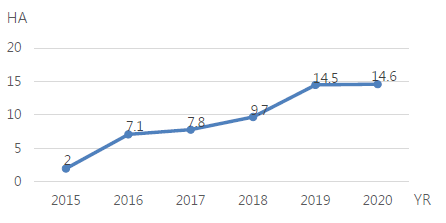
Figure 25. Friendly agriculture farming area in past years
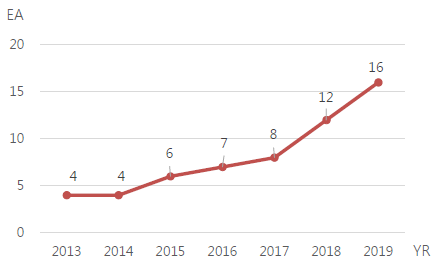
Figure 26. Friendly farming households in past years
In total, 16 farmers (including demonstration farms) and 11 farms currently plant with the ideas of friendly environment, of which 4 farms plant coffee, dragon fruit, black tea, and cinnamon. These farms have not only completed certification for organic vegetable, fruits and green conservation labels, but have also developed related processed products and flavored meals, and have even cooperated their products with the community organizations to promote experiential activities, with an annual yield of up to 8 million NT dollars. Other farmers in the community that have not yet completed certification have started to apply natural farming and do not use chemical pesticides. They have done so to collaboratively link the eco-friendly agriculture partner networks of Yi Hsin as well as contribute to the biological diversity.
Learning a lesson
1. Friendly farming and conservation ecology starts with certification
Daily output of water bamboo in season, which lasts from May to late June and early July, is about 500kg. Current organic channels may not be able to digest the boom of output; moreover, general channels might result in large losses for organic and green conservation lable farmers. The community has indicated that it was hard to live on organic farming, as the output in the beginning of the transformation period is reduced a half. During this time, general farmers have a hard life. The experiential water bamboo tours were promoted to make up for the losses in the transformation process. Nonetheless, visitors have doubts about the use of pesticide when going to farms during experiential activities. After reflection, they realize that farmers who do not eat water bamboo with pesticides do not sell conventionally grown products to others.
It is therefore suggested that the environmental assessment of a creditable third party and certification through pesticide examination should be done before starting organic and friendly farming to avoid consumer doubt about agricultural products, so as to connect with subsequent marketing.
2. Seeking assistance from public/private agencies and experts/scholars
In addition to adhering with internal consensus, it is important for the community to seek assistance from external agencies in a timely manner. Yi Hsin Community has successfully integrated governmental resources. It is suggested that communities seek local government departments in charge of river courses to restore river courses through natural engineering, agricultural education related departments to assist farmers in friendly agriculture farming, professional product marketing agencies for environmental and friendly product certification and marketing, and related species research institutes to acquire biological knowledge and environment investigation skills.
3. Diverse income to balance the economic needs during organic agriculture transformation
In the transformation of secondary and tertiary industries (agricultural products and farming experience), Yi Hsin Community has connected with other industries and integrated local resources to expand new-style sales models to balance economic needs. Different from individual sales of products, the model of “unite strength for a team battle” is the platform for production, sales, and processing. Experiential activities, including daily work in the village, can serve to develop diverse income with in-depth experience and environmental education through experience inheritance and sharing by old farmers to enhance production and sales (Hung, L.C, 2015). This shows that “farmers are not simply farmers, but can be professional interpreters” to serve more people.
Key information
- Farmers in Yi Hsin Community apply friendly agriculture farming to transform small pieces of farmland into ecological shelter pools for Pararasbora moltrechti and deepen the depth to form diverse ecological habitat. This addresses the problem of water pollution and maintains a complete environmental ecosystem.
- Yi Hsin Community produces many quality agricultural products through organic cultivation, farming advice and certification of organic products, diverse sales systems, and small farmers’ organic certifications. It has established trust between organic small farmers and consumers and developed an effective third-party organic agricultural certification system.
- A healthy environment is the basis for promoting the economy and way of living in the village. Continuous and long-term construction is important for the transformation of the community and the recovery of ecological production landscape.
- It is suggested that communities preliminarily ask experts & scholars in neighboring schools or the organizations and departments for assistance when unable to deal with environmental change, and enter into exchanges with mature communities to learn from their experience and even develop mutually agreed upon cooperation mechanisms to enhance self-capability and achieve the sustainable development of the community.
- Cohesion is an important part in the promotion of community affairs for executing plans that have reached community consensus, developing related systems, and influencing other residents’ participation in public affairs step by step.
- The pattern of ecological tourism can linearly connect tourist spots in the community. Such spots can be linked together to create a new direction for development and land utilization in a community and plan for a common vision.
Funding
The Soil and Water Conservation Bureau, Council of Agriculture, Executive Yuan, (SWCB) supported this work under the “Promotion of Taiwan’s (Satoyama) ecological agricultural villages”.
Reference
- Taiwan Public Television Service Foundation-Our land (2021,May 31). Serious drought, Pararasbora moltrechti looking for water to drink. https://youtu.be/2OTjdOxb-tg.
- Wu, C.-F.; Lee, C. Y.; Huang, C.-C.; Chuang, H.-Y.; Weng, C.-C.; Chen, M. C.; Chang, C.-H.; Chen, S.-H.; Zhang, Y.-T.; Lu, K. C. (2021). Chapter7: Sustainable Rural Development and Water Resources Management on a Hilly Landscape: A Case Study of Gonglaoping Community, Taichung, ROC (Chinese Taipei). In: Fostering Transformative Change for Sustainability in the Context of Socio-Ecological Production Landscapes and Seascapes (SEPLS); Springer, Singapore, pp.115-131.Doi: https://doi.org/10.1007/978-981-33-6761-6_7
- Soil and Water Conservation Bureau, Council of Agriculture, Executive Yuan(2020), Houhu Bridge upstream creek engineering[Unpublished thesis]. Soil and Water Conservation Bureau, Council of Agriculture, Executive Yuan.
- Yi Hsin Community (2020), Yi Hsin Biodiversity Monitoring Project[Unpublished thesis]. The Soil and Water Conservation Bureau Nantou Branch. https://nantou.swcb.gov.tw/
- Peng, K.D.& Chiu, M.L.(2019,December). Satoyama community’s biological habitat management and challenges: a case of improving the local practice of Pararasbora moltrechti refuge pool and river habitat in Yi Hsin community. Chen, J.C., Lin, H.M., Chen, T.K., Shih, M.C.& Su, B.J., International Conference Forum for 20th Anniversary of 921 Earthquake(1st,126-134). Soil and Water Conservation Bureau Nantou Branch, Council of Agriculture, Executive Yuan.
- Li, Z.Y.( 2019, March). Overview of Satoyama ecological village in Taiwan, visit to 30 ecologically potential communities in Taiwan. Soil and Water Conservation bureau, Council of Agriculture, Executive Yuan. https://nantou.swcb.gov.tw/
- Dunbar, W. (2019). Concept of resilience in SEPLS. Paper presented at the International Workshop on Resilience Assessment of SEPLS, Taiwan.
- Chao, J.-T.; Chen, J.-D.; Liao, C.; Lee, C.-Y.; Wang, C.-H.; Lee, L.-L. (2019). Taking care of the elderly as the core of rural transformation in Shangde community, Taitung, ROC (Chinese Taipei). Available online: https://satoyama-initiative.org/case_studies/taking-care-of-the-elderly-as-the-core-of-rural-transformation-in-shangde-community-taitung-taiwan/ (accessed on 3 June 2021)
- Council Of Agriculture Executive Yuan R.O.C(2019, January 9), COUNCIL OF AGRICULTURE, EXECUTIVE YUAN Notice is hereby given, for the amendment of “Schedule of Protected Species”, and the renaming of the Schedule as “Schedule of Protected Land Species”. The Executive Yuan Gazette Online,25(6),2-39. https://gazette.nat.gov.tw/egFront/detail.do?metaid=104095
- Chao, J.-T.; Lin, Y.-H.; Lee, C.-Y.; Huang, C.-C.; Lee, L.-L. (2018). Transformations towards sustainability – A SEPL restored by the Gongrong community. Available online: https://satoyama-initiative.org/case_studies/transformations-towards-sustainability-a-sepl-restored-by-the-gongrong-community/ (accessed on 3 June 2021)
- Huang, J.H., Su, J.F.& Chen, P.S.(2018). Regulating the Harvest Period of Water Bamboo by Use of Night-time Lighting and Shoots Cut-off . Journal of Taiwan Agricultural Research, 67(3),309-317. doi:10.6156/JTAR.201809_67(3).0008
- Lan, S.C.(2018,October). Demonstration meeting on the application of agricultural by-products in the friendly cultivation of wild bamboo shoots, Taichung District Agricultural Research monthly, (230),4-4(3).
- Lee, K.-C.; Fan, M.; Yang, R.-F.; Chen, S.-Y.; Kung, L.-Y.; Chang, H.-F.; Yan, S. Y. (2018). Building up Multi-stakeholder Cross-sector Partnerships for the ‘Xinshe Forest-River-Village-Sea Ecoagriculture Initiative’ in Eastern Rural Taiwan. Available online: https://satoyama-initiative.org/case_studies/building-up-multi-stakeholder-cross-sector-partnerships-for-the-xinshe-forest-river-village-sea-ecoagriculture-initiative-in-eastern-rural-taiwan/ (accessed on 15 June 2021).
- Scholes, L. Montanarella, A. Brainich, N. Barger, B. ten Brink, M. Cantele, B. Erasmus, J. Fisher, T. Gardner, T. G. Holland, F. Kohler, J. S. Kotiaho, G. Von Maltitz, G. Nangendo, R. Pandit, J. Parrotta, M. D. Potts, S. Prince, M. Sankaran and L. Willemen (eds.) (2018).Summary forpolicymakers of the assessment report on land degradation and restoration of the Intergovernmental Science-Policy Platform on Biodiversity and Ecosystem Services.
- Tsai,C.L.,Gao, P.S.& Chen, M.J. (2018, December 28) .Visit to Japan for the exchange of experience in rural Regeneration plan. Soil and Water Conservation Bureau, Council of Agriculture, Executive Yuan.
- Lin, D.L.(2016 ,March). The Aichi Biodiversity Targets and Biodiversity Indicators. Nature Conservation Quarterly,93,4-17.
- Council Of Agriculture Executive Yuan R.O.C.( 2015,October 20). Support Green New Life, Revive Wildlife. AGRICULTURE Policy & Review,280.
- Hung, L.C. (2015,October 1).Protection of water and life, Pararasbora moltrechti coming back. Organic Attitude, 28. https://toaf.org.tw/about/magazine/145-magazine028/233-magazine03d028
- F.D. Barrett, L. Cocora, R, Moreno-Peñaranda, A, Mcdonald (2011). Biodiversity in Kanazawa – Through the four seasons. Kanazawa, Japan: United Nations University-Institute of Advanced Studies Operating Unit Ishikawa/KanazawaBooklet.doi:10.13140/RG.2.1.2668.0807
- Council Of Agriculture Executive Yuan R.O.C(2009,January 20). COUNCIL OF AGRICULTURE. EXECUTIVE YUAN Notice is hereby given, to commence a period of public comment for the draft amendment of “Schedule of Protected Species”. The Executive Yuan Gazette Online ,15 (14),38.
- Healey, P. (1998). Building institutional capacity through collaborative approaches to urban planning. Environment and Planning A: Economy and Space, 30(9). doi: 10.1068/a301531

